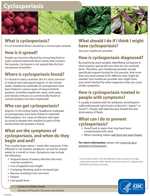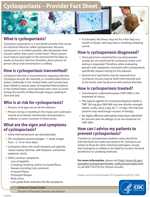Cyclosporiasis FAQs for Health Professionals
On this Page
- What is Cyclospora?
- How is Cyclospora transmitted?
- Who is at risk for Cyclospora infection?
- What are the symptoms of Cyclospora infection?
- How is Cyclospora infection diagnosed?
- How is Cyclospora infection treated?
- How is Cyclospora infection prevented?
- Additional perspective about laboratory testing for Cyclospora
What is Cyclospora?
Cyclospora cayetanensis is a unicellular parasite that causes an intestinal infection called cyclosporiasis. Because Cyclospora is a coccidian parasite, infected people shed oocysts (rather than cysts) in their feces.
How is Cyclospora transmitted?
By ingesting infective Cyclospora oocysts (for example, in contaminated food or water). Outbreaks in the United States and Canada have been linked to various types of imported fresh produce.
Cyclospora cayetanensis completes its life cycle in humans. However, the oocysts shed in the feces of infected persons must mature (sporulate) outside the host, in the environment, to become infective for someone else. Therefore, direct person-to-person (fecal-oral) transmission of Cyclospora is unlikely. The process of maturation (sporulation) is thought to require from days to weeks.
Who is at risk for Cyclospora infection?
Persons living or traveling in the tropics and subtropics may be at increased risk for infection because cyclosporiasis is endemic in some countries in these zones. In some regions, infection appears to be seasonal. But the seasonality varies in different settings and is not well understood.
What are the symptoms of Cyclospora infection?
The incubation period between acquisition of infection and onset of symptoms averages ~1 week (ranges from ~2-14 or more days). Cyclospora infects the small intestine and typically causes watery diarrhea, with frequent, sometimes explosive, stools. Other common symptoms include loss of appetite, weight loss, abdominal cramping/bloating, increased flatus, nausea, and prolonged fatigue. Vomiting, body aches, low-grade fever, and other flu-like symptoms may be noted. If untreated, the illness may last for a few days to a month or longer, and may follow a remitting-relapsing course. Some infected persons are asymptomatic, particularly in settings where cyclosporiasis is endemic.
How is Cyclospora infection diagnosed?
The most important point for health care providers to realize about the diagnosis of Cyclospora infection is that stool specimens examined for ova and parasites usually are not examined for Cyclospora unless such testing is requested. Therefore, when evaluating persons with symptoms consistent with cyclosporiasis, specifically request testing for this parasite. If indicated, stool specimens also should be checked for other microbes that can cause a similar illness.
Another important point is that Cyclospora oocysts may be shed intermittently and at low levels, even by persons with profuse diarrhea. A single negative stool specimen does not exclude the diagnosis; several specimens—that are processed and examined with sensitive methods—may be required.
(Additional perspective about laboratory testing is provided below.)
How is Cyclospora infection treated?
Trimethoprim-sulfamethoxazole (TMP-SMX), or Bactrim*, Septra*, or Cotrim*, is the treatment of choice. The typical regimen for immunocompetent adults is TMP 160 mg plus SMX 800 mg (one double-strength tablet), orally, twice a day, for 7-10 days. HIV-infected patients may need longer courses of therapy.
No highly effective alternatives have been identified for persons who are allergic to (or are intolerant of) TMP-SMX. Approaches to consider for such persons include observation and symptomatic treatment, use of an antibiotic whose effectiveness against Cyclospora is based on limited data, or desensitization to TMP-SMX. The latter approach should be considered only for selected patients who require treatment, have been evaluated by an allergist, and do not have a life-threatening allergy.
Anecdotal or unpublished data suggest that the following drugs are ineffective: albendazole, trimethoprim (when used as a single agent), azithromycin, nalidixic acid, tinidazole, metronidazole, quinacrine, tetracycline, doxycycline, and diloxanide furoate. Although data from a small study among HIV-infected patients in Haiti suggested that ciprofloxacin might have modest activity against Cyclospora, substantial anecdotal experience among many immunocompetent persons suggests that ciprofloxacin is ineffective.
* Trimethoprim–sulfamethoxazole (TMP–SMX) is available for human use in the United States.
More on: Treatment for Cyclosporiasis
How is Cyclospora infection prevented?
On the basis of currently available information, avoiding food or water that might have been contaminated with stool is the best way to prevent infection. Symptomatic reinfection can occur.
Additional perspective about laboratory testing for Cyclospora
- Cyclospora oocysts are easily overlooked; low-level shedding (~1-2 logs lower than for Cryptosporidium species) is common. To maximize recovery of Cyclospora oocysts, first concentrate the stool specimen—such as by the formalin-ethyl acetate technique (centrifuge for 10 minutes at 500 x g)—and then examine a wet mount and/or a stained slide of the sediment.
- Cyclospora oocysts are ~8-10 micrometers in diameter (in contrast, Cryptosporidium parvum/hominis oocysts are ~4-6 micrometers in diameter).
- Ultraviolet fluorescence microscopy (UV excitation filter set at 330-365 nm or 450-490 nm) is a sensitive technique for rapidly examining stool sediments for Cyclospora oocysts, which stand out because they autofluoresce (Cryptosporidium parvum/hominis oocysts do not). If suspect Cyclospora oocysts are found, bright-field, phase contrast, or differential interference contrast microscopy can then be used to confirm that the structures have the characteristic morphologic features of Cyclospora oocysts (i.e., are nonrefractile spheres that contain undifferentiated cytoplasm or refractile globules).
- On a modified acid-fast—stained slide of stool, Cyclospora oocysts typically are variably acid fast (i.e., in the same field, oocysts may be unstained or stain from light pink to deep red). Unstained oocysts characteristically have a wrinkled (hyaline) appearance.
- If a "hot" modified safranin technique is used, Cyclospora oocysts uniformly stain a brilliant reddish orange.
More on: Laboratory Methods [DPDx]
* Use of trade names is for identification only and does not imply endorsement by the Public Health Service or by the U.S. Department of Health and Human Services.
Trimethoprim–sulfamethoxazole
Note on Treatment in Pregnancy
Trimethoprim–sulfamethoxazole (TMP–SMX) is in pregnancy category C. TMP–SMX should be used during pregnancy only if the potential benefit justifies the potential risk to the fetus. TMP-SMX should be avoided near-term because of the potential for hyperbilirubinemia and kernicterus in the newborn.
Pregnancy Category C: Either studies in animals have revealed adverse effects on the fetus (teratogenic or embryocidal, or other) and there are no controlled studies in women or studies in women and animals are not available. Drugs should be given only if the potential benefit justifies the potential risk to the fetus.
Note on Treatment During Lactation
Trimethoprim–sulfamethoxazole (TMP–SMX) is excreted in breast milk. TMP–SMX generally is compatible with breastfeeding of healthy, full-term infants after the newborn period. However, TMP-SMX generally should be avoided by women when nursing infants who are premature, jaundiced, ill, or stressed, or who have glucose-6-phosphate dehydrogenase deficiency.
Note on Treatment in Pediatric Patients
The safety of trimethoprim–sulfamethoxazole (TMP–SMX) in children has not been systematically evaluated. Use in children less than 2 months of age generally is not recommended
- Page last reviewed: June 13, 2014
- Page last updated: June 13, 2014
- Content source:



 ShareCompartir
ShareCompartir
